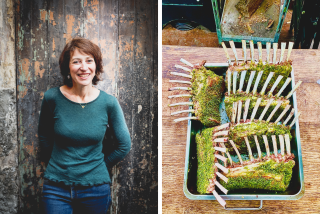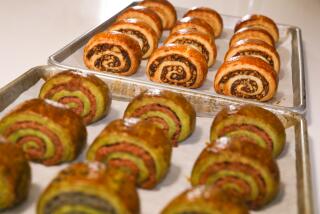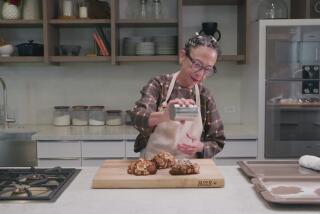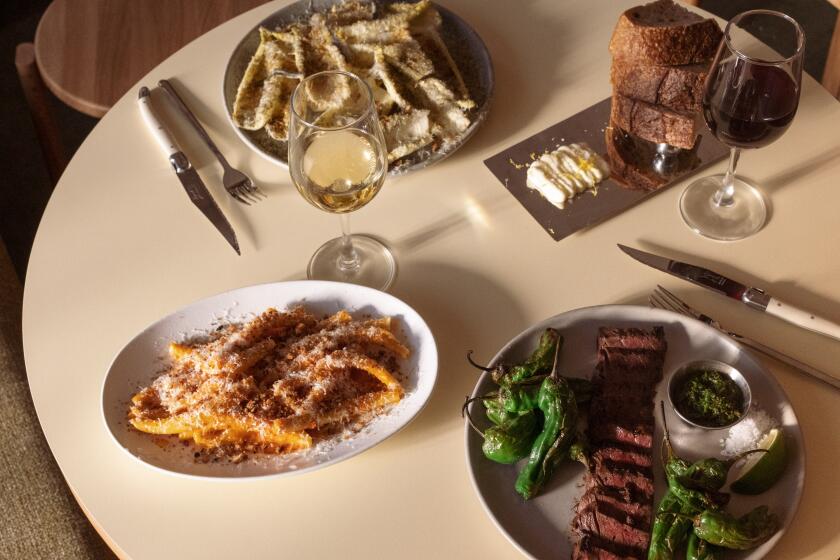Master Class: Hot cross buns with a citrus twist
Last spring, James Beard Award finalist Margarita Manzke said the customers in the out-the-door line at her bakery case at République kept asking her for hot cross buns. Manzke filled a few special orders for regulars and now has created a recipe for the classic Easter pastry for us based on the brioche in her new cookbook “Baking at République,” co-written with Betty Hallock, a former Times deputy food editor.
She flavors the dough with a spice mix she uses in her Christmas stollen and adds candied local oranges to the traditional rum-soaked currant-raisin blend. To echo the citrus baked into the buns, Manzke perfumes the icing with orange blossom water, which she pipes on after baking to keep that delicate scent intact.
Manzke loves making brioche dough, but acknowledges it can be intimidating. To make her formula even more foolproof, she uses instant yeast, which she considers more reliable for rising. Here are a few tips to ensure République-like results:
- The butter should be cool but malleable. If it’s too hard, it won’t blend into the dough and end up as chunks that melt during baking. If it’s too warm, it’ll melt while mixing and make the dough greasy. To check if your butter’s at the right temperature, squeeze a cube between your fingers. You should feel a little resistance, but be able to press it flat without it breaking into bits. Chill it again if it’s softened too much; let it stand at room temperature longer if it’s too hard.
- Put the dough through the windowpane test. Right before you add the dried fruit, spread a piece with your hands: It should stretch thin enough for you to see light shining through it. If it breaks, mix it some more.
- Wait for the rise. Rely on touch to see when the buns are ready for the oven: the dough shouldn’t bounce back when poked; instead, you should feel the air trapped inside, sort of like a bubble-gum bubble.
- Adjust the glaze consistency. It’s easier to thin a thick glaze, so start with the proportions below. If it’s too thick to pipe, add a tiny dribble of milk and stir. Repeat until the glaze is just pipeable. You want nice clear lines.
- Don’t serve these hot. Yes, it’s in the name, but the glaze will melt and run if warmed.
Hot Cross Buns
View recipe in our California Cookbook »
4 hours, mainly inactive, plus overnight chilling. Makes about 20 buns.
Even before you taste the citrus in these tender buttery buns, you can smell it in the glaze. That heady floral scent followed by the chewy sweetness of candied orange peel brightens the flavor of typical hot cross buns.
Buns
2/3 cup currants
1/4 cup raisins
1/4 cup diced candied orange peel
2 tablespoons rum
2 1/2 cups all-purpose flour, plus more for dusting
1/3 cup granulated sugar
1 cup high-fat European-style unsalted butter, cut into ½-inch cubes
4 large eggs, plus 1 large egg white
4 tablespoons whole milk
1 teaspoon fine sea salt
1 teaspoon instant yeast
1/4 teaspoon each ground cardamom, cloves, nutmeg, cinnamon and allspice
1 Make the buns: Put the currants, raisins, candied orange peel, rum and 2 tablespoons water in a small bowl. Stir well, then let stand until the liquid completely soaks into the fruit, 2 to 8 hours.
2 Half an hour before making the buns, refrigerate the flour and sugar in separate bowls and let the butter stand at room temperature.
3 In the bowl of a stand mixer fitted with the dough hook, mix the whole eggs and 3 tablespoons milk on the lowest speed just to blend. Add the flour, salt, yeast, cardamom, cloves, nutmeg, cinnamon and allspice and mix on the lowest speed until incorporated into the liquid. Scrape the bowl, then raise the speed to high and mix for 2 minutes. With the machine running, rain in the sugar slowly, letting it incorporate before adding more; this should take about 5 to 7 minutes. The dough will start to come off the hook at this point and get a little softer.
4 Scrape the bowl and add all the butter. Mix on high to fully incorporate the butter, scraping the bowl once or twice, for about 10 minutes. The dough will form a mass around the hook and pull away from the sides of the bowl with a slight thwacking sound. The dough is done when it is glossy, smooth and moist but not sticky.
5 Add the dried fruit mixture and mix on low speed until evenly distributed, 1 to 2 minutes. Coat a large bowl or container with cooking spray. Place the dough in the bowl and roll it around to coat with the oil. Cover with plastic wrap and let rise in a warm place (75 to 85 degrees) for 30 minutes.
6 Turn the dough out onto a lightly floured work surface. Gently flatten the dough and fold into thirds as you would a letter. Turn it 90 degrees and fold it the same way again. Return the dough to the bowl seam-side down, cover, and let rise until nearly doubled in size, about 30 minutes. Transfer to the refrigerator and chill for 12 hours.
7 Turn the dough out onto a lightly floured work surface. Cut the dough into about 20 pieces (50 grams each). Form each piece into a ball by folding in the edges of a cut dough piece toward the center and pull and pinch the seams shut. Put the ball seam side down on the work surface, cup it with one hand and roll until smooth. Place the balls 2 inches apart on a large baking sheet lined with parchment paper. Loosely cover with plastic wrap and let rise in a warm place until doubled in size, about 1 1/2 hours. The gifs below show how to form tight balls of dough that won’t unravel when baked in the oven.
8. Heat the oven to 350 degrees. Whisk the egg white with the remaining 1 tablespoon milk in a small bowl to make an egg wash. Using a pastry brush, gently brush each risen bun with the wash.
9. Bake until dark golden brown, about 15 minutes. Cool completely in the pans on wire racks, about 30 minutes.
Icing
1 1/4 cups powdered sugar (169 g)
2 tablespoons whole milk (28 g)
1/4 teaspoon orange blossom water
1. Make the icing: In a small bowl, stir together the powdered sugar, milk and orange blossom water to create a thick consistency that should not run when piped.
2. Fill a pastry bag fitted with a quarter-inch plain round tip, or a resealable plastic bag with a quarter-inch hole snipped in one corner, with the icing. Pipe a line along each row of buns, then repeat in the other direction to create crosses. Let stand until the icing is set. Serve immediately.
Adapted from Margarita Manzke
More to Read
Eat your way across L.A.
Get our weekly Tasting Notes newsletter for reviews, news and more.
You may occasionally receive promotional content from the Los Angeles Times.











